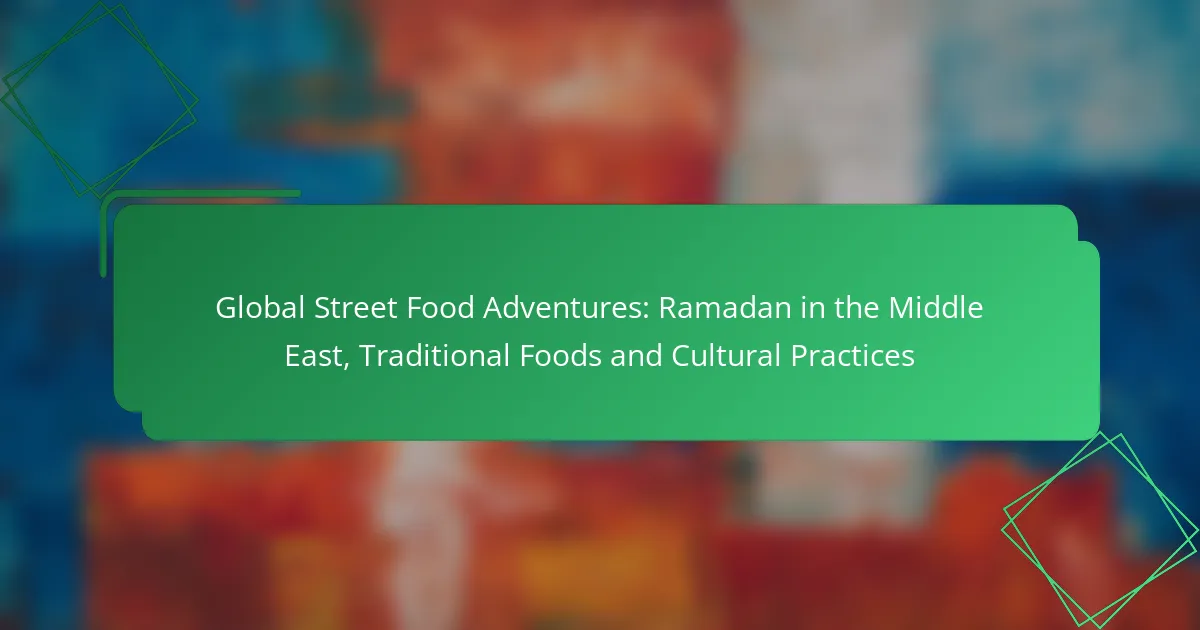Ramadan in the Middle East is a vibrant celebration marked by the rich tapestry of traditional foods and cultural practices. As families gather for iftar, the meal that breaks the fast, they share a variety of dishes that highlight local ingredients and heritage, fostering a sense of community and togetherness. This sacred month not only emphasizes nourishment but also spiritual growth and charitable acts, deepening the bonds among individuals and families.
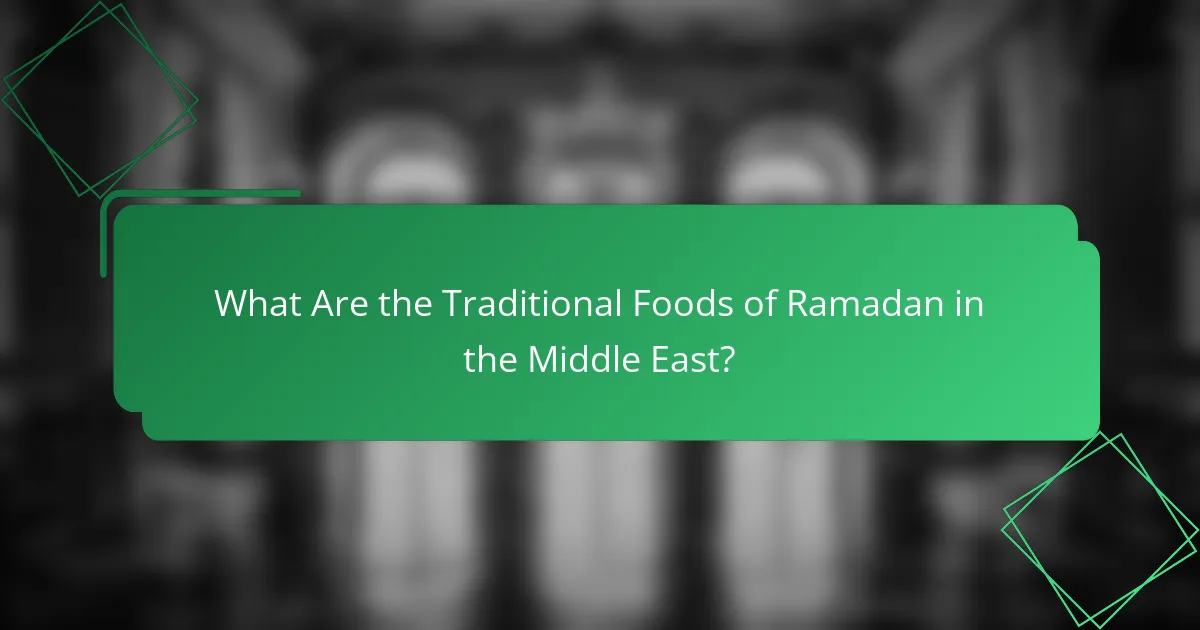
What Are the Traditional Foods of Ramadan in the Middle East?
During Ramadan in the Middle East, traditional foods play a vital role in breaking the fast and fostering community. Meals often feature a variety of dishes that reflect cultural heritage and local ingredients, focusing on nourishment and celebration.
Dates and Water
Dates and water are the quintessential foods for breaking the fast during Ramadan. Traditionally, Muslims consume dates first, as they provide quick energy and hydration after a day of fasting. The natural sugars in dates help replenish energy levels effectively.
It is common to serve dates with a glass of water or milk, and some may choose to accompany them with traditional drinks like qamar al-din, a sweet apricot juice. This combination is not only nutritious but also steeped in cultural significance.
Hummus and Pita
Hummus, a creamy dip made from chickpeas, tahini, and olive oil, is a staple during Ramadan meals. It is typically served with warm pita bread, making it a popular choice for both iftar and suhoor. The dish is rich in protein and healthy fats, providing sustained energy.
Hummus can be customized with various toppings such as olive oil, paprika, or pine nuts, allowing for a range of flavors. It is often enjoyed with fresh vegetables, enhancing its nutritional value and adding freshness to the meal.
Fattoush Salad
Fattoush salad is a refreshing dish made with mixed greens, tomatoes, cucumbers, and crispy pieces of pita bread. This salad is often dressed with a tangy lemon and sumac vinaigrette, making it a vibrant addition to any Ramadan table. The variety of textures and flavors makes it a favorite among many.
Including fattoush in meals during Ramadan not only adds color but also provides essential vitamins and minerals. It is a great way to incorporate more vegetables into the diet, promoting overall health during the fasting month.
Stuffed Grape Leaves
Stuffed grape leaves, known as dolmas, are a popular dish during Ramadan. They are typically filled with a mixture of rice, herbs, and sometimes minced meat, then rolled and cooked until tender. This dish is often served warm or at room temperature, making it versatile for iftar gatherings.
Dolmas can be enjoyed with yogurt or a squeeze of lemon for added flavor. They represent a labor of love, as preparing them can be time-consuming, but the communal aspect of making and sharing them enhances their significance during Ramadan.
Baklava
Baklava is a rich, sweet pastry made of layers of filo dough filled with chopped nuts and sweetened with honey or syrup. This dessert is a beloved treat during Ramadan, often served at the end of iftar meals. Its flaky texture and sweet flavor make it a delightful indulgence.
While baklava can be found in various forms across the Middle East, each region has its unique twist on the recipe. It is commonly enjoyed with Arabic coffee or tea, providing a perfect balance of sweetness and bitterness to conclude the meal.
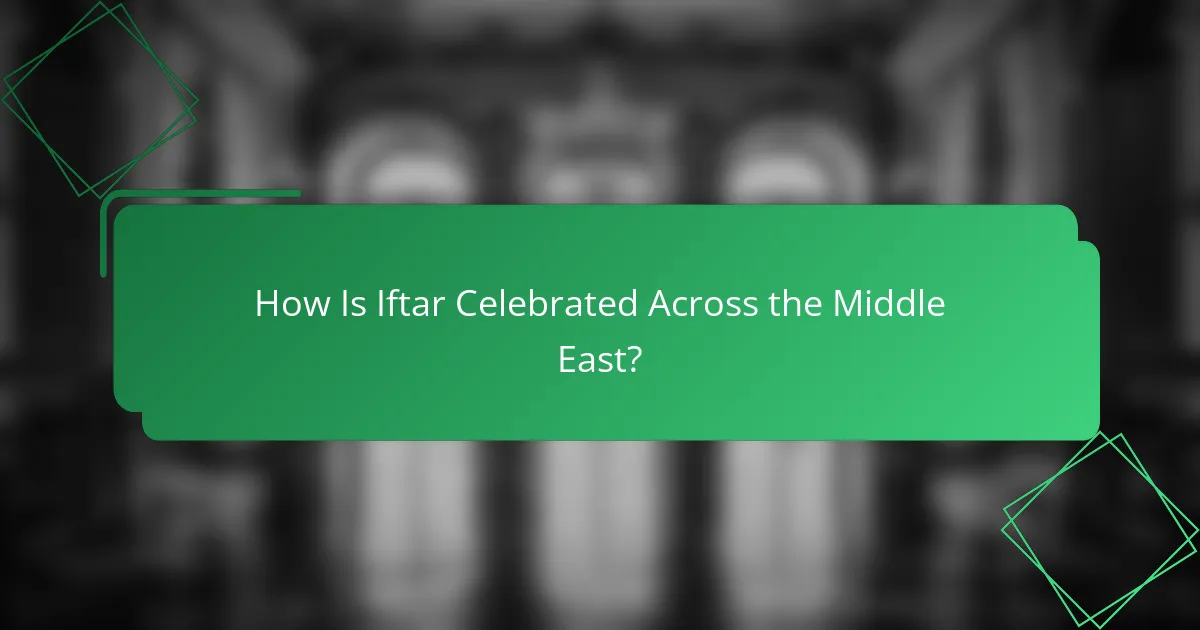
How Is Iftar Celebrated Across the Middle East?
Iftar, the meal to break the fast during Ramadan, is celebrated with great enthusiasm across the Middle East. Families and communities come together to enjoy traditional foods and engage in cultural practices that enhance the spirit of the month.
Community Gatherings
Community gatherings during Iftar often take place in mosques, community centers, or public spaces, where people share meals and connect. These events foster a sense of unity and belonging, as individuals from diverse backgrounds come together to break their fasts.
In many cities, local governments may organize large communal Iftar meals, providing food for those in need and encouraging social interaction. These gatherings can attract hundreds or even thousands of participants, creating a vibrant atmosphere filled with joy and camaraderie.
Family Traditions
Family traditions around Iftar vary widely but often include preparing special dishes that have been passed down through generations. Families typically gather at sunset to share a meal, starting with dates and water, followed by a variety of savory and sweet dishes.
In countries like Egypt, traditional foods such as koshari or lentil soup are common, while in Lebanon, dishes like fattoush and tabbouleh are popular. Each family may have its own unique recipes, reflecting regional ingredients and cultural influences.
Special Events
During Ramadan, many cities host special events to celebrate Iftar, including food festivals and cultural performances. These events often feature local chefs showcasing traditional dishes, allowing attendees to sample a variety of flavors and culinary techniques.
In addition to food, cultural activities such as music and dance performances may take place, enriching the Iftar experience. These events not only highlight the culinary diversity of the region but also promote cultural exchange and understanding among different communities.
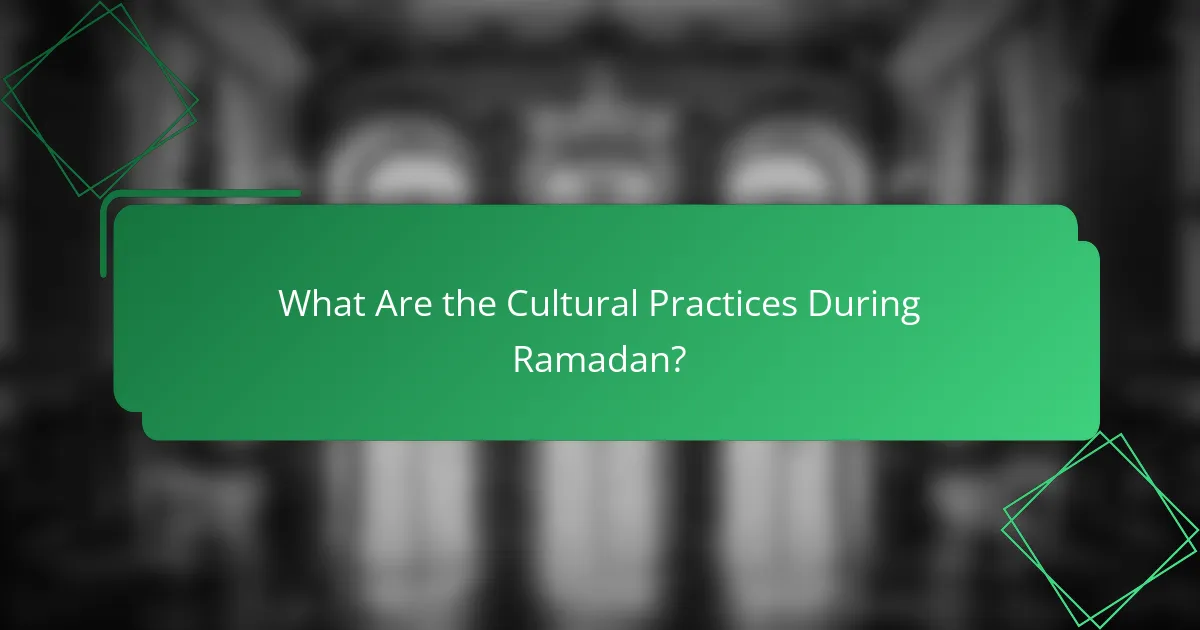
What Are the Cultural Practices During Ramadan?
During Ramadan, cultural practices focus on spiritual growth, community bonding, and charitable acts. Muslims engage in various traditions that enhance their faith and foster a sense of togetherness.
Charity and Giving
Charity, or Zakat, is a fundamental practice during Ramadan. Muslims are encouraged to give generously to those in need, often increasing their donations during this holy month. Many choose to calculate their Zakat based on their savings, typically around 2.5% of their wealth, to support the less fortunate.
In addition to Zakat, many engage in Sadaqah, voluntary charity that can take various forms, such as food donations or financial support. This spirit of giving strengthens community ties and ensures that everyone can partake in the Ramadan festivities.
Prayer and Reflection
Prayer and reflection are central to Ramadan, with Muslims increasing their daily prayers and engaging in spiritual contemplation. The five daily prayers are often supplemented with additional prayers, known as Tarawih, performed at night after the Isha prayer.
Reflection during this month encourages individuals to assess their lives and strengthen their relationship with God. Many use this time to read the Quran, with the goal of completing it by the end of Ramadan, enhancing their spiritual connection.
Fasting Rules
Fasting, or Sawm, is one of the Five Pillars of Islam and is observed from dawn until sunset during Ramadan. Muslims abstain from food, drink, smoking, and marital relations during daylight hours, focusing instead on spiritual growth and self-discipline.
Exceptions to fasting include individuals who are ill, elderly, pregnant, nursing, or traveling. Those unable to fast are encouraged to provide meals to the needy or make up the fast at a later date. It is essential to maintain hydration and nutrition during non-fasting hours, often breaking the fast with dates and water, followed by a hearty meal.
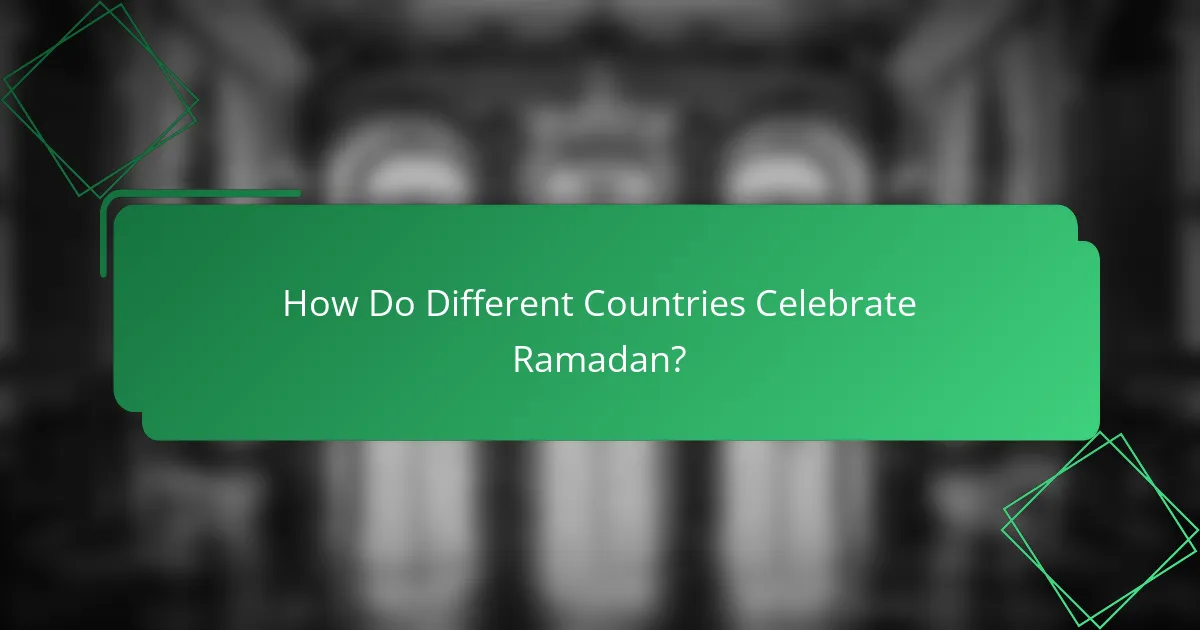
How Do Different Countries Celebrate Ramadan?
Countries around the world celebrate Ramadan with unique cultural practices and traditional foods that reflect their heritage. While the core tenets of fasting and prayer are universal, local customs and culinary delights vary significantly from one nation to another.
Egyptian Ramadan Traditions
In Egypt, Ramadan is marked by vibrant festivities and communal gatherings. Families often break their fast with dates and a traditional drink called Qamar al-Din, made from apricot puree. The evenings are filled with social activities, including nightly prayers at mosques and special events in public spaces.
One notable tradition is the preparation of special meals, such as Koshari and Mahshi, which are enjoyed during Iftar. Street vendors play a significant role, offering a variety of snacks and sweets like Konafa and Basbousa, making the streets lively and bustling during the holy month.
Saudi Arabian Iftar Customs
In Saudi Arabia, Iftar is a significant event that often begins with the consumption of dates and water, following the Sunnah of the Prophet Muhammad. Families gather to share meals that typically include dishes like Kabsa, a spiced rice dish with meat, and various salads and appetizers.
Hospitality is paramount during Ramadan, with many Saudis inviting friends and neighbors to join their Iftar meals. The tradition of giving to charity, known as Zakat, is also emphasized, with many choosing to donate food or money to those in need during this holy month.
Jordanian Ramadan Foods
Jordanian cuisine during Ramadan features a rich array of traditional dishes that reflect the country’s cultural heritage. Popular Iftar items include Mansaf, a lamb dish served with rice and yogurt, and various types of bread, which are staples in Jordanian households.
During Ramadan, sweets such as Ma’amoul, filled with dates or nuts, are commonly enjoyed. Families often prepare large quantities of food to share with neighbors and the less fortunate, fostering a sense of community and generosity throughout the month.
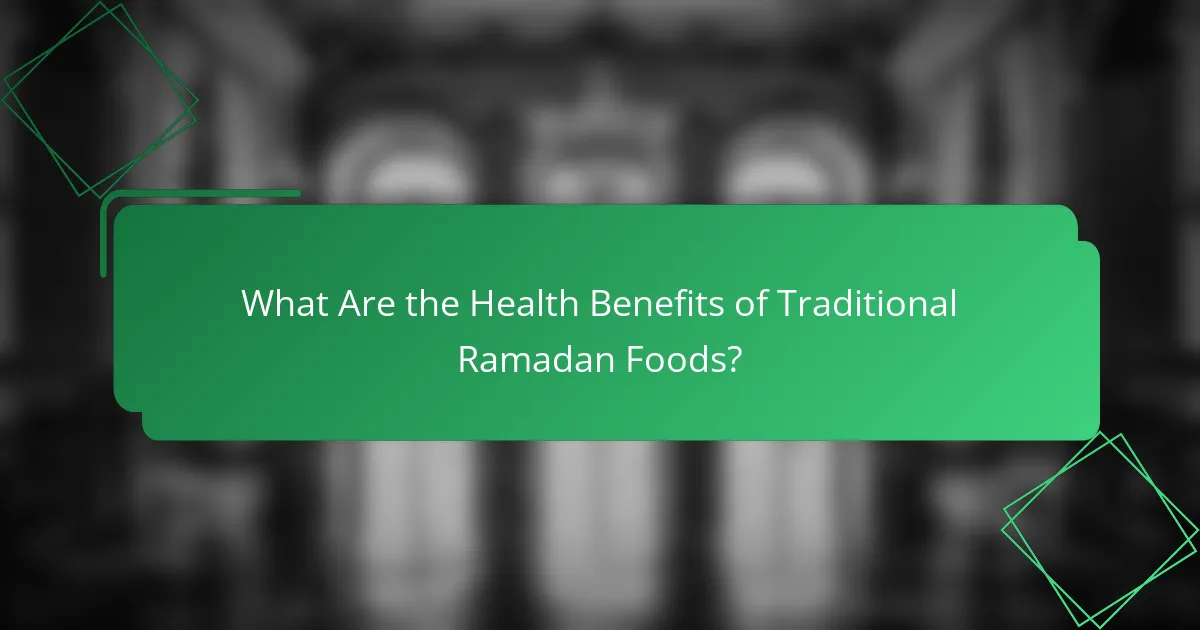
What Are the Health Benefits of Traditional Ramadan Foods?
Traditional Ramadan foods offer various health benefits, primarily by providing essential nutrients and energy after fasting. These foods often include a balance of carbohydrates, proteins, and healthy fats, which help sustain energy levels and support overall health during the month-long observance.
Nutritional Value of Dates
Dates are a staple food during Ramadan, particularly for breaking the fast. They are rich in natural sugars, fiber, and essential minerals like potassium and magnesium, making them an excellent source of quick energy and aiding digestion.
Consuming dates can help replenish glycogen stores in the liver and muscles, which is crucial after a day of fasting. Their high fiber content also promotes satiety, helping to control hunger throughout the evening meals.
Incorporating dates into your diet during Ramadan can be simple. Consider enjoying them with nuts for a balanced snack, or adding them to smoothies for a nutritious boost. Aim for a handful each day to maximize their health benefits without overindulging.
